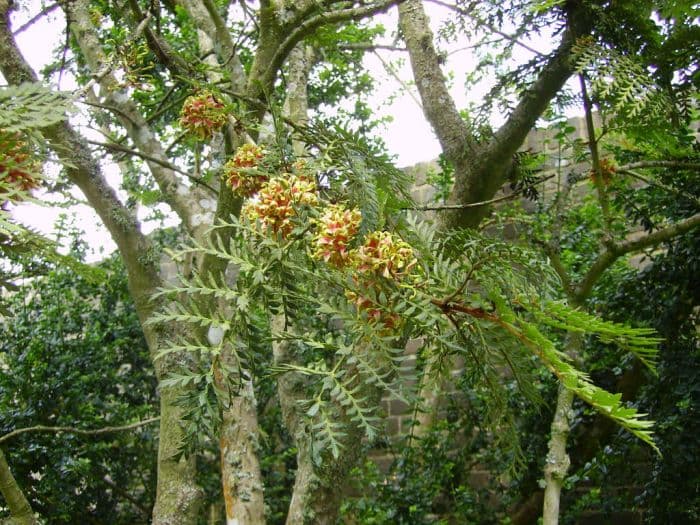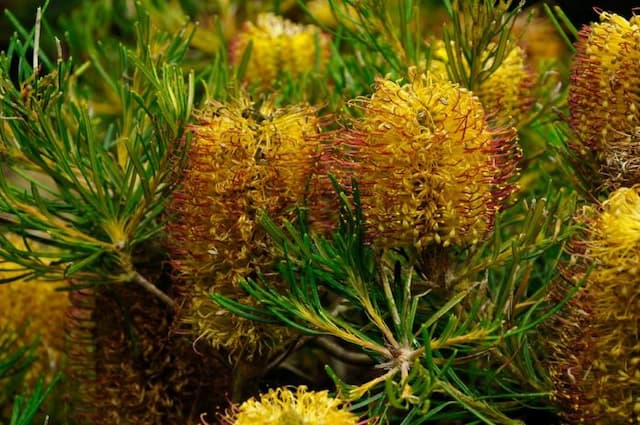Chilean Lomatia Lomatia ferruginea

ABOUT
The plant commonly known as the Chilean Lomatia features a distinctive appearance with evergreen foliage. Its leaves are pinnately divided, meaning they are arranged on either side of a central stem much like the feathers of a bird, and each leaf is adorned with several narrow, lance-shaped leaflets with pointed tips. The leaves often exhibit a leathery texture and may have a slightly glossy surface that catches the light. The color of the foliage tends to be a deep green, which may contrast with the rusty-brown undersides, giving the plant its specific common name referring to a 'rusty' look. Throughout its blooming period, the Chilean Lomatia produces eye-catching flowers. These blooms are generally organized into clusters known as inflorescences and can be very showy. The individual flowers possess numerous long, conspicuous stamens that may be seen protruding from the center, adding an ornamental appeal to the plant. The petals surrounding these stamens are often delicate and may range in color from pale pink to a deep rose, creating a lovely display against the backdrop of its verdant leaves. After flowering, the plant develops fruit that is equally interesting. The fruits typically appear in the form of follicles, which are dry fruits that open on one side to release seeds. The textural and visual interest of the fruits can add to the ornamental value of the plant even after the flowering season has ended. Overall, the Chilean Lomatia's distinctive leaf structure, charming flowers, and interesting fruit form make it a notable plant for ornamental purposes, especially in gardens that aim to showcase unique and attractive flora.
About this plant
 Names
NamesFamily
Proteaceae.
Synonyms
Chilean Lomatia, Fuinque, Romerillo.
Common names
Lomatia hirsuta, Lomatia dentata
 Toxicity
ToxicityTo humans
Lomatia ferruginea, commonly known as the Chilean lomatia, is not widely recognized for its toxicity to humans. There is limited information on the poisonous effects it has if ingested. However, as with many plants, it is generally advisable to avoid consuming parts of plants unless they are known to be safe, as they can contain compounds that might be harmful. If a plant is unknown or not typically consumed for food, it is best to err on the side of caution and not ingest it. If you suspect poisoning from any plant, seek medical attention immediately. Symptoms of plant poisoning can vary but may include gastrointestinal distress, nausea, vomiting, dizziness, or more severe reactions depending on the individual's sensitivity and the amount ingested.
To pets
Lomatia ferruginea, or Chilean lomatia, has not been specifically documented for its toxicity in pets such as dogs and cats. However, the general rule for pets is to prevent them from eating plants that are not confirmed to be safe, as pets may have different sensitivities or reactions to certain plant compounds. If a pet ingests part of this plant and shows symptoms of illness—such as vomiting, diarrhea, drooling, or changes in behavior—it's important to consult a veterinarian as soon as possible. Pets can react differently to various plants and substances, so it is crucial to monitor their well-being and get professional help if you observe any signs of distress following ingestion of plant material.
 Characteristics
CharacteristicsLife cycle
Perennials
Foliage type
Evergreen
Color of leaves
Green
Flower color
Red
Height
3-10 feet (0.91-3.05 meters)
Spread
2-6 feet (0.61-1.83 meters)
Plant type
Shrub
Hardiness zones
8
Native area
Chile
Benefits
 General Benefits
General Benefits- Ecosystem Support: Lomatia ferruginea, known as "Fuinque," provides habitat and food for a variety of wildlife species, helping to maintain biodiversity.
- Ornamental Use: With its attractive foliage and flowers, Fuinque is often used in gardening and landscaping for aesthetic appeal.
- Soil Improvement: Fuinque can help with soil stabilization and prevent erosion, thus improving soil quality and structure in its native habitat.
- Climate Resilience: As a native species, Fuinque is adapted to local conditions and can help ecosystems withstand and recover from the impacts of climate change.
- Cultural Significance: Fuinque holds cultural importance for indigenous peoples and local communities in its native range.
 Medical Properties
Medical Properties- Anti-inflammatory: Lomatia ferruginea, commonly known as Fuinque, contains compounds that may reduce inflammation.
- Antioxidant: The plant has antioxidant properties due to the presence of polyphenolic compounds.
- Antiviral: There is some evidence to suggest that extracts of Fuinque may have antiviral activity.
- Antibacterial: Fuinique extracts have been reported to show antibacterial effects.
- Antifungal: The plant has been studied for its potential antifungal properties.
- Analggesic: There are claims that Lomatia ferruginea may have pain-relieving effects.
- Immunomodulatory: Fuinque may have the capacity to modulate the immune system.
 Air-purifying Qualities
Air-purifying QualitiesThis plant is not specifically known for air purifying qualities.
 Other Uses
Other Uses- Lomatia ferruginea, commonly known as Fuinque, is used as an ornamental plant in gardens and parks due to its attractive evergreen foliage and red inflorescences.
- The wood of Fuinque is dense and has been used traditionally for crafting tool handles and other small wooden items by the indigenous peoples of its native habitat.
- The flowers of the Fuinque plant can be used in floral arrangements as they provide a unique and exotic touch.
- Fuinque's leathery leaves are sometimes employed in craftwork for decoration or as a natural stencil material due to their shape and durability.
- Extracts from Fuinque leaves have been used in the perfume industry as a source of fragrance components, although this is not a common practice.
- In its native range, Fuinque's branches and foliage may be used in ceremonial practices or as a natural symbol in cultural rituals.
- The plant's distinctive appearance makes it a subject for botanical illustration and plant taxonomy studies, contributing to scientific knowledge and artistic endeavors.
- In some regions, Fuinque has been used for revegetation projects to stabilize soil and prevent erosion because of its robust root system.
- Due to its ability to grow in harsh climate conditions, Fuinque can act as a windbreak or a natural barrier in landscape design.
- Although not a primary use, the seeds of Fuinque have been collected for propagation and horticultural study, preserving the species and contributing to biodiversity conservation efforts.
Interesting Facts
 Feng Shui
Feng ShuiLomatia ferruginea is not used in Feng Shui practice.
 Zodiac Sign Compitability
Zodiac Sign CompitabilityLomatia ferruginea is not used in astrology practice.
 Plant Symbolism
Plant Symbolism- Endurance: Commonly known as the "Fuinque," Lomatia ferruginea is native to the temperate rainforests of southern Chile and Argentina, an environment that requires strength to survive. This robustness makes it a symbol of endurance.
- Uniqueness: The Fuinque has a distinctive, attractive appearance with rusty-colored undersides of its leaves. Its uniqueness can symbolize individuality and the beauty of standing out.
- Adaptability: Thriving in cool, damp habitats, the Fuinque represents adaptability, as it is well-tuned to its specific ecological niche, illustrating the ability to thrive in or adapt to one's environment.
 Water
WaterThe Chilean firetree, commonly known as the Chilean firebush, prefers consistent moisture but does not fare well in waterlogged soil. During the growing season, water the plant thoroughly once a week, allowing for the top inch of soil to dry out between waterings. As a general guideline, provide about one to two gallons of water, depending on the size of the plant and environmental conditions such as heat and humidity. During the dormant season, reduce watering frequency but ensure the soil does not completely dry out. Always water at the base of the plant to avoid wetting the foliage, which can lead to fungal diseases.
 Light
LightThe Chilean firebush thrives best in full sun to partial shade conditions. Ideally, plant it in a location where it can receive at least six hours of direct sunlight daily, but it can also tolerate some light afternoon shade. Avoid deep shade as it will result in less robust growth and fewer flowers.
 Temperature
TemperatureThe ideal temperature range for the Chilean firebush is between 50°F and 70°F. It can tolerate a minimum temperature down to around 20°F but is not frost-tolerant for prolonged periods. To ensure optimal growth and flowering, protect the plant from extreme cold and provide a microclimate or shelter if you live in an area with cold winters.
 Pruning
PruningPrune the Chilean firebush to remove dead or damaged branches and to shape the plant in late winter or early spring before new growth commences. Pruning encourages healthy growth and enhances flowering. It's also a good time to thin out any crowded branches to ensure good air circulation. Prune the plant every year or every other year, as needed, to maintain its structure and health.
 Cleaning
CleaningAs needed
 Soil
SoilFor Chilean Firetree, a well-draining soil mix that includes peat moss, perlite, and sand works best, mimicking its native conditions. Aim for a slightly acidic to neutral pH of about 5.5 to 7.
 Repotting
RepottingThe Chilean Firetree doesn't require frequent repotting; when young, it may be repotted biennially, but mature plants can be repotted every 3 to 4 years.
 Humidity & Misting
Humidity & MistingChilean Firetree prefers moderate to high humidity levels but is adaptable to less humid environments if not exposed to dry air drafts.
 Suitable locations
Suitable locationsIndoor
Provide bright light and well-draining soil for indoor Chilean Firetree.
Outdoor
In partial shade to full sun, plant Chilean Firetree in well-draining soil.
Hardiness zone
8-10 USDA
 Life cycle
Life cycleLomatia ferruginea, commonly known as the Fuinque, begins its life cycle as a seed, which requires a well-drained soil and a moist environment to germinate. After germination, a seedling emerges and establishes itself, undergoing a period of growth where it develops roots, shoots, and leaves. As it matures into a young plant, the Fuinque starts to form its distinctive pinnate leaves and may take several years to reach reproductive maturity. Once mature, the plant produces clusters of red, yellow, or orange flowers during the spring and summer, which are then pollinated by insects or other means. Following pollination, seeds develop within woody fruits, which when mature, are dispersed by gravity or animal vectors to new growing locations. The perennial nature of Lomatia ferruginea allows it to survive for many years, with individual plants capable of reaching an advanced age, completing the cyclical process as they contribute new seeds to the population.
 Propogation
PropogationPropogation time
Spring-Early Summer
For the Chilean firetree (Lomatia ferruginea), the most popular method of propagation is by seed. The best time to sow seeds is in the spring after the last frost has passed. Fresh seeds should be collected and sown in well-draining soil, kept at a temperature of around 70°F (21°C), and maintained in a bright, indirect light setting. Seeds usually take several weeks to germinate, and it's essential to keep the soil consistently moist but not waterlogged during this period. It is recommended to transplant the seedlings to individual pots once they have developed a couple of true leaves and are large enough to handle.




